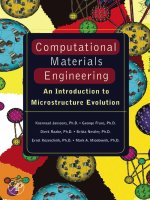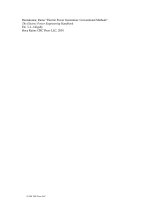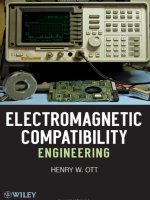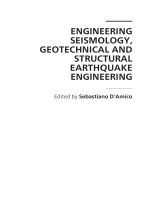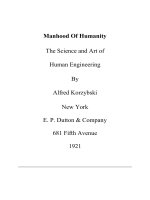Electromagnetic Compatibility Engineering pot
Bạn đang xem bản rút gọn của tài liệu. Xem và tải ngay bản đầy đủ của tài liệu tại đây (27.66 MB, 862 trang )
Electromagnetic Compatibility
Engineering
Electromagnetic Compatibility
Engineering
Henry W. Ott
Henry Ott Consultants
Copyright r 2009 by John Wiley & Sons, Inc. All rights reserved.
Published by John Wiley & Sons, Inc., Hoboken, New Jersey.
Published simultaneously in Canada.
No part of this publication may be reproduced, stored in a retrieval system, or transmitted in any
form or by any means, electronic, mechanical, photocopying, recording, scanning, or otherwise,
except as permitted under Section 107 or 108 of the 1976 United States Copyright Act, without
either the prior written permission of the Publisher, or authorization through payment of the
appropriate per-copy fee to the Copyright Clearance Center, Inc., 222 Rosewood Drive, Daitvers,
MA 01923, (978) 750-8400, fax (978) 750-4470, or on the web at www.copyright.com. Requests to
the Publisher for permission should be addressed to the Permissions Department, John Wiley &
Sons, Inc., 111 River Street, Hoboken, NJ 07030, (201) 748-6011, fax (201) 748-6008, or online at
/>Limit of Liability/Disclaimer of Warranty: While the publisher and author have used their best
efforts in preparing this book, they make no representations or warranties with respect to the
accuracy or completeness of the contents of this book and specifically disclaim any implied
warranties of merchantability or fitness for a particular purpose. No warranty may be created or
extended by sales representatives or written sales materials. The advice and strategies contained
herein may not be suitable fur your situation. You should consult with a professional where
appropriate. Neither the publisher nor author shall be liable for any loss of profit or any other
commercial damages, including but not limited to special, incidental, consequential, or other
damages.
For general information on our other products and services or for technical support, please contact
our Customer Care Department within the United States at (800) 762-2974, outside the United
States at (317) 572-3993 or fax (317) 572-4002.
Wiley also publishes its books in a variety of electronic formats. Some content that appears in print
may not be available in electronic formats. For more information about Wiley products, visit our
web site at www.wiley.com.
Library of Congress Cataloging-in-Publication Data:
Ott, Henry W., 1936-
Electromagnetic compatibility engineering / Henry W. Ott. – Rev. ed.
p. cm.
Earlier ed. published under title: Noise reduction techniques in electronic systems, 1988.
Includes bibliographical references and index.
ISBN 978-0-470-18930-6
1. Electronic circuits–Noise. 2. Electromagnetic compatibility.
I. Ott, Henry W., 1936- Noise reduction techniques in electronic systems. II. Title.
TK7867.5.O867 2009
621.382u24—dc22 2009006814
Printed in the United States of America
10987654321
To my parents, the late Henry and Virginia Ott.
The values they instilled in me as a child have served me well throughout my life.
Everything should be made as simple as possible, but no simpler.
Albert Einstein, 1879–1955
CONTENTS
Preface xxiii
PART 1 EMC THEORY 1
1. Electromagnetic Compatibility 3
1.1 Introduction 3
1.2 Noise and Interference 3
1.3 Designing for Electromagnetic Compatibility 4
1.4 Engineering Documentation and EMC 6
1.5 United States’ EMC Regulations 6
1.5.1 FCC Regulations 6
1.5.2 FCC Part 15, Subpart B 8
1.5.3 Emissions 11
1.5.4 Administrative Procedures 14
1.5.5 Susceptibility 17
1.5.6 Medical Equipment 17
1.5.7 Telecom 18
1.5.8 Automotive 19
1.6 Canadian EMC Requirements 19
1.7 European Union’s EMC Requirements 20
1.7.1 Emission Requirements 20
1.7.2 Harmonics and Flicker 22
1.7.3 Immunity Requirements 23
1.7.4 Directives and Standards 23
1.8 International Harmonization 26
1.9 Military Standards 27
vii
1.10 Avionics 28
1.11 The Regulatory Process 30
1.12 Typical Noise Path 30
1.13 Methods of Noise Coupling 31
1.13.1 Conductively Coupled Noise 31
1.13.2 Common Impedance Coupling 32
1.13.3 Electric and Magnetic Field Coupling 33
1.14 Miscellaneous Noise Sources 33
1.14.1 Galvanic Action 33
1.14.2 Electrolytic Action 35
1.14.3 Triboelectric Effect 35
1.14.4 Conductor Motion 36
1.15 Use of Network Theory 36
Summary 38
Problems 39
References 41
Further Reading 42
2. Cabling 44
2.1 Capacitive Coupling 45
2.2 Effect of Shield on Capacitive Coupling 48
2.3 Inductive Coupling 52
2.4 Mutual Inductance Calculations 54
2.5 Effect of Shield on Magnetic Coupling 56
2.5.1 Magnetic Coupling Between Shield and Inner Conductor 58
2.5.2 Magnetic Coupling—Open Wire to Shielded Conductor 61
2.6 Shielding to Prevent Magnetic Radiation 64
2.7 Shielding a Receptor Against Magnetic Fields 67
2.8 Common Impedance Shield Coupling 69
2.9 Experimental Data 70
2.10 Example of Selective Shielding 74
2.11 Shield Transfer Impedance 75
2.12 Coaxial Cable Versus Twisted Pair 75
viii CONTENTS
2.13 Braided Shields 79
2.14 Spiral Shields 81
2.15 Shield Terminations 84
2.15.1 Pigtails 84
2.15.2 Grounding of Cable Shields 88
2.16 Ribbon Cables 94
2.17 Electrically Long Cables 96
Summary 96
Problems 98
References 103
Further Reading 104
3. Grounding 106
3.1 AC Power Distribution and Safety Grounds 107
3.1.1 Service Entrance 108
3.1.2 Branch Circuits 109
3.1.3 Noise Control 111
3.1.4 Earth Grounds 114
3.1.5 Isolated Grounds 116
3.1.6 Separately Derived Systems 118
3.1.7 Grounding Myths 119
3.2 Signal Grounds 120
3.2.1 Single-Point Ground Systems 124
3.2.2 Multipoint Ground Systems 126
3.2.3 Common Impedance Coupling 128
3.2.4 Hybrid Grounds 130
3.2.5 Chassis Grounds 131
3.3 Equipment/System Grounding 132
3.3.1 Isolated Systems 133
3.3.2 Clustered Systems 133
3.3.3 Distributed Systems 140
3.4 Ground Loops 142
3.5 Low-Frequency Anal ysis of Common-Mode Choke 147
3.6 High-Frequency Analysis of Common-Mode Choke 152
3.7 Single Ground Ref erence for a Circuit 154
CONTENTS ix
Summary 155
Problems 156
References 157
Further Reading 157
4. Balancing and Filtering 158
4.1 Balancing 158
4.1.1 Common-Mode Rejection Ratio 161
4.1.2 Cable Balance 165
4.1.3 System Balance 166
4.1.4 Balanced Loads 166
4.2 Filtering 174
4.2.1 Common-Mode Filters 174
4.2.2 Parasitic Effects in Filters 177
4.3 Power Supply Decoupling 178
4.3.1 Low-Frequency Analog Circuit Decoupling 183
4.3.2 Amplifier Decoupling 185
4.4 Driving Capacitive Loads 186
4.5 System Bandwidth 188
4.6 Modulation and Coding 190
Summary 190
Problems 191
References 192
Further Reading 193
5. Passive Components 194
5.1 Capacitors 194
5.1.1 Electrolytic Capacitors 195
5.1.2 Film Capacitors 197
5.1.3 Mica and Ceramic Capacitors 198
5.1.4 Feed-Through Capacitors 200
5.1.5 Paralleling Capacitors 202
5.2 Inductors 203
5.3 Transformers 204
5.4 Resistors 206
5.4.1 Noise in Resistors 207
x CONTENTS
5.5 Conductors 208
5.5.1 Inductance of Round Conductors 209
5.5.2 Inductance of Rectangular Conductors 210
5.5.3 Resistance of Round Conductors 211
5.5.4 Resistance of Rectangular Conductors 213
5.6 Transmission Lin es 215
5.6.1 Characteristic Impedance 217
5.6.2 Propagation Constant 220
5.6.3 High-Frequency Loss 221
5.6.4 Relationship Among C, L and e
r
. 224
5.6.5 Final Thoughts 225
5.7 Ferrites 225
Summary 233
Problems 234
References 237
Further Reading 237
6. Shielding 238
6.1 Near Fields and Far Fields 238
6.2 Characteristic and Wave Impedances 241
6.3 Shielding Effectiveness 243
6.4 Absorption Loss 245
6.5 Reflection Loss 249
6.5.1 Reflection Loss to Plane Waves 252
6.5.2 Reflection Loss in the Near Field 253
6.5.3 Electric Field Reflection Loss 254
6.5.4 Magnetic Field Reflection Loss 255
6.5.5 General Equations for Reflection Loss 256
6.5.6 Multiple Reflections in Thin Shields 256
6.6 Composite Absorption and Reflection Loss 257
6.6.1 Plane Waves 257
6.6.2 Electric Fields 258
6.6.3 Magnetic Fields 259
6.7 Summary of Shielding Equations 260
6.8 Shielding with Magnetic Materials 260
6.9 Experimental Data 265
CONTENTS xi
6.10 Apertures 267
6.10.1 Multiple Apertures 270
6.10.2 Seams 273
6.10.3 Transfer Impedance 277
6.11 Waveguide Below Cutoff 280
6.12 Conductive Gaskets 282
6.12.1 Joints of Dissimilar Metals 283
6.12.2 Mounting of Conductive Gaskets 284
6.13 The ‘‘IDEAL’’ Shield 287
6.14 Conductive Windows 288
6.14.1 Transparent Conductive Coatings 288
6.14.2 Wire Mesh Screens 289
6.14.3 Mounting of Windows 289
6.15 Conductive Coatings 289
6.15.1 Conductive Paints 291
6.15.2 Flame/Arc Spray 291
6.15.3 Vacuum Metalizing 291
6.15.4 Electroless Plating 292
6.15.5 Metal Foil Linings 292
6.15.6 Filled Plastic 293
6.16 Internal Shields 293
6.17 Cavity Resonance 295
6.18 Grounding of Shields 296
Summary 296
Problems 297
References 299
Further Reading 300
7. Contact Protection 302
7.1 Glow Discharges 302
7.2 Metal-Vapor or Arc Discharges 303
7.3 AC Versus DC Circuits 305
7.4 Contact Material 306
7.5 Contact Rating 306
7.6 Loads with High Inrush Currents 307
xii CONTENTS
7.7 Inductive Loads 308
7.8 Contact Protection Fundamentals 310
7.9 Transient Suppression for Inductive Loads 314
7.10 Contact Protection Netwo rks for Inductive Loads 318
7.10.1 C Network 318
7.10.2 R–C Network 318
7.10.3 R–C–D Network 321
7.11 Inductive Loads Controlled by a Transistor Switch 322
7.12 Resistive Load Contact Protection 323
7.13 Contact Protection Selection Guide 323
7.14 Examples 324
Summary 325
Problems 326
References 327
Further Reading 327
8. Intrinsic Noise Sources 328
8.1 Thermal Noise 328
8.2 Characteristics of Thermal Noise 332
8.3 Equivalent Noise Bandwidth 334
8.4 Shot Noise 337
8.5 Contact Noise 338
8.6 Popcorn Noise 339
8.7 Addition of Noise Voltages 340
8.8 Measuring Random Noise 341
Summary 342
Problems 343
References 345
Further Reading 345
9. Active Device Noise 346
9.1 Noise Factor 346
9.2 Measurement of Noise Factor 349
CONTENTS xiii
9.2.1 Single-Frequency Method 349
9.2.2 Noise Diode Method 350
9.3 Calculating S/N Ratio and Input Noise Voltage
from Noise Factor 351
9.4 Noise Voltage and Current Model 353
9.5 Measurment of V
n
and I
n
355
9.6 Calculating Noise Factor and S/N Ratio from V
n
–I
n
356
9.7 Optimum Source Resistance 357
9.8 Noise Factor of Cascaded Stages 360
9.9 Noise Temperature 362
9.10 Bipolar Transistor Noise 364
9.10.1 Transistor Noise Factor 365
9.10.2 V
n
–I
n
for Transistors 367
9.11 Field-Effect Transistor Noise 368
9.11.1 FET Noise Factor 368
9.11.2 V
n
–I
n
Representation of FET Noise 370
9.12 Noise in Operational Amplifiers 370
9.12.1 Methods of Specifying Op-Amp Noise 373
9.12.2 Op-Amp Noise Factor 375
Summary 375
Problems 376
References 377
Further Reading 378
10. Digital Circuit Grounding 379
10.1 Frequency Versus Time Domain 380
10.2 Analog Versus Digital Circuits 380
10.3 Digital Logic Noise 380
10.4 Internal Noise Sources 381
10.5 Digital Circuit Ground Noise 384
10.5.1 Minimizing Inductance 385
10.5.2 Mutual Inductance 386
10.5.3 Practical Digital Circuit Ground Systems 388
10.5.4 Loop Area 390
xiv CONTENTS
10.6 Ground Plane Current Distribution and Impedance 391
10.6.1 Reference Plane Current Distribution 392
10.6.2 Ground Plane Impedance 400
10.6.3 Ground Plane Voltage 408
10.6.4 End Effects 409
10.7 Digital Logic Current Flow 412
10.7.1 Microstrip Line 414
10.7.2 Stripline 415
10.7.3 Digital Circuit Current Flow Summary 418
Summary 419
Problems 420
References 421
Further Reading 422
PART 2 EMC APPLICATIO NS 423
11. Digital Circuit Power Distribution 425
11.1 Power Supply Decoupling 425
11.2 Transient Power Supply Currents 426
11.2.1 Transient Load Current 427
11.2.2 Dynamic Internal Current 428
11.2.3 Fourier Spectrum of the Tran sient Current 429
11.2.4 Total Transient Current 431
11.3 Decoupling Capac itors 431
11.4 Effective Decoupling Strategies 436
11.4.1 Multiple Decoupling Capacitors 437
11.4.2 Multiple Capacitors of the Sa me Value 437
11.4.3 Multiple Capacitors of Two Different Values 440
11.4.4 Multiple Capacitors of Many Different Values 444
11.4.5 Target Impedance 445
11.4.6 Embedded PCB Capacitance 447
11.4.7 Power Supply Isolation 452
11.5 The Effect of Decoupling on Radiated Emissions 454
11.6 Decoupling Capac itor Type and Value 456
11.7 Decoupling Capac itor Placement and Mounting 457
11.8 Bulk Decoupling Capacitors 459
CONTENTS xv
11.9 Power Entry Filters 460
Summary 461
Problems 461
References 463
Further Reading 463
12. Digital Circuit Radiation 464
12.1 Differential-Mode Radiation 465
12.1.1 Loop Area 468
12.1.2 Loop Current 468
12.1.3 Fourier Series 468
12.1.4 Radiated Emission Envelope 470
12.2 Controlling Differential-Mode Radiation 471
12.2.1 Board Layout 471
12.2.2 Canceling Loops 474
12.2.3 Dithered Clocks 475
12.3 Common-Mode Radiation 477
12.4 Controlling Common-Mode Radiation 480
12.4.1 Common-Mode Voltage 481
12.4.2 Cable Filtering and Shielding 482
12.4.3 Separate I/O Grounds 485
12.4.4 Dealing With Common-Mode Radiation Issues 488
Summary 488
Problems 489
References 490
Further Reading 491
13. Conducted Emissions 492
13.1 Power Line Impedance 492
13.1.1 Line Impedance Stabilization Network 494
13.2 Switched-Mode Power Supplies 495
13.2.1 Common-Mode Emissions 498
13.2.2 Differential-Mode Emissions 501
13.2.3 DC-to-DC Converters 509
13.2.4 Rectifier Diode Noise 509
xvi CONTENTS
13.3 Power-Line Filters 511
13.3.1 Common-Mode Filtering 512
13.3.2 Differential-Mode Filtering 512
13.3.3 Leakage Inductance 513
13.3.4 Filter Mounting 516
13.3.5 Power Supplies with Integral Power-Line Filters 519
13.3.6 High-Frequency Noise 520
13.4 Primary-to-Secondary Common-Mode Coupling 523
13.5 Frequency Dithering 524
13.6 Power Supply Instability 524
13.7 Magnetic Field Emissions 525
13.8 Variable Speed Motor Drives 528
13.9 Harmonic Suppression 536
13.9.1 Inductive Input Filters 538
13.9.2 Active Power Factor Correction 538
13.9.3 AC Line Reactors 539
Summary 541
Problems 542
References 544
Further Reading 544
14. RF and Transient Immunity 545
14.1 Performance Criteria 545
14.2 RF Immunity 546
14.2.1 The RF Environment 547
14.2.2 Audio Rectification 548
14.2.3 RFI Mitigation Techniques 549
14.3 Transient Immun ity 557
14.3.1 Electrostatic Discharge 558
14.3.2 Electrical Fast Transient 558
14.3.3 Lightning Surge 559
14.3.4 Transient Suppression Networks 560
14.3.5 Signal Line Suppression 561
14.3.6 Protection of High-Speed Signal Lines 564
14.3.7 Power Line Transient Suppression 566
14.3.8 Hybrid Protection Network 570
CONTENTS xvii
14.4 Power Line Disturbances 572
14.4.1 Power Line Immunity Curve 573
Summary 575
Problems 576
References 578
Further Reading 579
15. Electrostatic Discharge 580
15.1 Static Generation 580
15.1.1 Inductive Charging 583
15.1.2 Energy Storage 585
15.2 Human Body Model 587
15.3 Static Discharge 589
15.3.1 Decay Time 590
15.4 ESD Protection in Equipment Design 592
15.5 Preventing ESD Entry 594
15.5.1 Metallic Enclosures 595
15.5.2 Input/Output Cable Treatment 599
15.5.3 Insulated Enclosures 604
15.5.4 Keyboards and Control Panels 607
15.6 Hardening Sensitive Circuits 608
15.7 ESD Grounding 608
15.8 Nongrounded Produ cts 609
15.9 Field-Induced Upset 610
15.9.1 Inductive Coupling 611
15.9.2 Capacitive Coupling 611
15.10 Transient Hardened Softw are Design 612
15.10.1 Detecting Errors in Program Flow 613
15.10.2 Detecting Errors in Input/Output 614
15.10.3 Detecting Errors in Memory 616
15.11 Time Windows 617
Summary 617
Problems 619
xviii CONTENTS
References 620
Further Reading 621
16. PCB Layout and Stackup 622
16.1 General PCB Layout Considerations 622
16.1.1 Partitioning 622
16.1.2 Keep Out Zones 622
16.1.3 Critical Signals 623
16.1.4 System Clocks 624
16.2 PCB-to-Chassis Ground Connection 625
16.3 Return Path Discontinuities 626
16.3.1 Slots in Ground/Power Planes 627
16.3.2 Split Ground/Power Planes 628
16.3.3 Changing Reference Planes 630
16.3.4 Referencing the Top and Bottom of the Same Plane 633
16.3.5 Connectors 634
16.3.6 Ground Fill 634
16.4 PCB Layer Stackup 635
16.4.1 One- and Two-Layer Boards 636
16.4.2 Multilayer Boards 637
16.4.3 General PCB Design Procedure 653
Summary 655
Problems 657
References 658
Further Reading 658
17. Mixed-Signal PCB Layout 660
17.1 Split Ground Planes 660
17.2 Microstrip Ground Plane Current Distribution 662
17.3 Analog and Digital Ground Pins 665
17.4 When Should Split Ground Planes Be Used? 668
17.5 Mixed Signal ICs 669
17.5.1 Multi-Board Systems 671
17.6 High-Resolution A/D and D/A Converters 671
17.6.1 Stripline 673
CONTENTS xix
17.6.2 Asymmetric Stripline 674
17.6.3 Isolated Analog and Digital Ground Planes 675
17.7 A/D and D/A Converter Support Circuitry 676
17.7.1 Sampling Clocks 676
17.7.2 Mixed-Signal Support Circuitry 678
17.8 Vertical Isolation 679
17.9 Mixed-Signal Power Distribution 681
17.9.1 Power Distribution 681
17.9.2 Decoupling 682
17.10 The IPC Problem 684
Summary 685
Problems 686
References 687
Further Reading 687
18. Precompliance EMC Measurements 688
18.1 Test Environment 689
18.2 Antennas Versus Probes 689
18.3 Common-Mode Currents on Cables 690
18.3.1 Test Procedure 693
18.3.2 Cautions 693
18.4 Near Field Measurements 694
18.4.1 Test Procedure 695
18.4.2 Cautions 696
18.4.3 Seams and Apertures in Enclosures 697
18.5 Noise Voltage Measurements 697
18.5.1 Balanced Differential Probe 698
18.5.2 DC to 1-GHz Probe 700
18.5.3 Cautions 700
18.6 Conducted Emiss ion Testing 700
18.6.1 Test Procedure 702
18.6.2 Cautions 703
18.6.3 Separating C-M from D-M Noise 704
18.7 Spectrum Analyzers 707
xx CONTENTS
18.7.1 Detector Functions 709
18.7.2 General Test Procedure 710
18.8 EMC Crash Cart 711
18.8.1 Mitigation Parts List 712
18.9 One-Meter Radiated Emission Measurements 713
18.9.1 Test Environment 713
18.9.2 Limits for 1-m Testing 713
18.9.3 Antennas for 1-m Testing 714
18.10 Precompliance Immunity Testing 717
18.10.1 Radiated Immunity 717
18.10.2 Conducted Immunity 720
18.10.3 Transient Immunity 721
18.11 Precompliance Power Quality Tests 723
18.11.1 Harmonics 724
18.11.2 Flicker 725
18.12 Margin 726
18.12.1 Radiated Emission Margin 726
18.12.2 Electrostatic Discharge Margin 727
Summary 728
Problems 729
References 730
Further Reading 731
APPENDIX 733
A. The Decibel 733
A.1 Properties of Logarithms 733
A.2 Using the Decibel for Other than Power Measurements 734
A.3 Power Loss or Negative Power Gain 736
A.4 Absolute Power Level 736
A.5 Summing Powers Expressed in Decibels 738
B. The Ten Best Ways to Maximize the Emission from Your Product 740
C. Multiple Reflections of Magnetic Fields in Thin Shield s 743
CONTENTS xxi
D. Dipoles for Dummies 746
D.1 Basic Dipoles for Dummies 746
D.2 Intermediate Dipoles for Dummies 751
D.3 Advanced Dipoles for Dummies 756
D.3.1 Impedance of a Dipole 756
D.3.2 Dipole Resonance 756
D.3.3 Receiving Dipole 759
D.3.4 Theory of Images 759
D.3.5 Dipole Arrays 761
D.3.6 Very High-Frequency Dipoles 763
Summary 763
Further Reading 764
E. Partial Inductance 765
E.1 Inductance 765
E.2 Loop Inductance 767
E.2.1 Inductance of a Rectangular Loop 768
E.3 Partial Inductance 770
E.3.1 Partial Self-Inductance 771
E.3.2 Partial Mutual Inductance 773
E.3.3 Net Partial-Inductance 776
E.3.4 Partial Inductance Applications 776
E.3.5 Transmission Line Example 778
E.4 Ground Plane Inductance Measurement Test Setup 780
E.5 Inductance Notation 785
Summary 788
References 788
Further Reading 789
F. Answers to Problems 790
Index 825
xxii CONTENTS
PREFACE
Electromagnetic Compatibility Engineering started out being a third edition to
my previous book Noise Reduction Techniques in Electronic Systems, but it
turned out to be much more than that, hence, the title change. Nine of the
original twelve chapters were completely rewritten. In addition, there are six
new chapters, plus two new appendices, with over 600 pages of new and revised
material (including 342 new figures). Most of the new material relates to the
practical application of the theory of electromagnetic compatibility (EMC)
engineering, and it is based on experience gained from my EMC consulting
work, and teaching of EMC training seminars over the last 20 plus years.
Some of the more difficult and frustrating problems faced by design
engineers concerns electromagnetic compatibility and regulatory compliance
issues. Most engineers are not well equipped to handle these problems because
the subject is not normally taught in engineering schools. Solutions to EMC
problems are often found by trial and error with little or no understanding of
the theory involved. Such efforts are very time consuming, and the solutions are
often unsatisfactory. This situation is unfortunate, because most of the
principles involved are simple and can be explained by elementary physics.
This book is intended to remedy that situation.
This book is intended primarily for the practicing engineer who is involved in
the design of electronic equipment or systems and is faced with EMC and
regulatory compliance issues. It addresses the practical aspects of electro-
magnetic compatibility engineering, covering both emission and immunity.
The concepts presented in this book are applicab le to both analog and digital
circuits operating from below audio frequencies up to the GHz range. Emphasis
is on cost-effective EMC designs, with the amount and complexity of the
mathematics kept to a minimum. The reader should obtain the knowledge
necessary to design electronic equipment that is compatible with the electro-
magnetic environment and compliant with national and international EMC
regulations.
The book is written in such a way that it can easily be used as a textbook for
teaching a senior level or continuing education course in electromagnetic
compatibility. To this end, the book contains 251 problems for the student
to work out, the answers to which are included in Appendix F.
xxiii
The book is divided into two parts: Part 1, EMC Theory and includes
Chapters 1 to 10. Part 2, EMC Applications, includes Chapters 11 to 18. In
addition, the book contains six appendices with supplemental information.
The organization of the material is as follows. Chapter 1 is an introduction
to electromagnetic compatibility and covers national and international EMC
regulations, including the European Union, FCC, and U.S. Military. Chapter 2
covers both electric and magnetic field cable coupling and crosstalk, as well as
cable shielding and grounding. Chapter 3 covers safety, power, signal, and
hardware/systems grounding.
Chapter 4 discusses balancing and filtering as well as differential amplifiers,
and low-frequency analog circuit decoupling. Chapter 5 is on passive compo-
nents and covers the nonideal characteristics of components that affect their
performance. In addition to resistors, capacitors, and inductors—fe rrite beads,
conductors and transmission lines are also included. Chapter 6 is a detailed
analysis of the shielding effectiveness of metallic sheets as well as conductive
coatings on plastic, and the effect of apertures on the shielding effectiveness.
Chapter 7 covers contact protection for relays and switche s. Chapters 8 and
9 discuss internal noise sources in components and active devices. Chapter 8
covers intrinsic noise sources, such as thermal and shot noise. Chapter 9 covers
noise sources in active devices.
Chapters 10, 11, and 12 cover electromagnetic compatibility issues asso-
ciated with digital circuits. Chapter 10 examines digital circuit g rounding,
including ground plane impedance and a discussion on how digital logic
currents flow. Chapter 11 is on digital circuit power distribution and decou-
pling, and Chapter 12 covers digital circuit radiation mechanisms, both
common mode and differential mode.
Chapter 13 covers conducted emissions on alternating current (ac) and direct
current (dc) power lines, as well as EMC issues associated with switching power
supplies and variable-speed motor drives. Chapter 14 covers radio frequen-
cy(rf) and transient immunity, as well as a discussion of the electromagnetic
environment. Chapter 15 covers electrostatic discharge protection in the design
of electronic products. It focuses on the importance of a three-prong approach,
which includes mechanical, electrical, and software design.
Chapter 16 covers printed circuit board layout and stackup, a subject not
often discussed. Chapter 17 addresses the difficult problem of partitioning,
grounding, and layout of mixed-signal print ed circuit boards.
The final chapter (Chapter 18) is on precompliance EMC measurements,
that is, measurements that can be performed in the product development
laboratory, using simple and inexpensive test equipment, which relate to the
EMC performance of the product.
At the end of each chapter, there is a summary of the most important points
discussed as well as many problems for the reader to work out. For those
desiring additional information on the subjects covered, each chapter has an
extensive reference, and further reading section.
xxiv PREFACE
Supplemental information is provided in six appendices. Appendix A is on
the decibel. Appendix B covers the 10 best ways to maximize the emission from
your product. Appendix C derives the equations for multiple reflections of
magnetic fields in thin shields.
Appendix D, ‘‘Dipoles for Dummies,’’ is a simple, insightful, and intuitive
discussion of how a dipole antenna works. If a product picks up or radiates
electromagnetic energy, then it is an antenna, therefore, an understanding of
some basic antenna theory would be helpful for all engineers, especially EMC
engineers.
Appendix E explains the important, and not well understood, theory of
partial inductance, and Appendix F provides answers to the problems con-
tained at the end of each chapter.
I would like to express my gratitude and appreciation to all those who took
the time to comment on Noise Reduction Techniques in Electronic Systems and
to all those who encouraged me to write Electromagnetic Compatibility
Engineering. In particular, I would especially like to thank John Celli, Bob
German, Dr. Clayton Paul, Mark Steffka, and Jim Brown for their insightful
review of major portions of the manuscript, as well as for their encouragement
and the many fruitful discussions we had on the subject of EMC. Electro-
magnetic Compatibility Engineering is a better book because of them.
Portions of the manuscript were also used for an electromagnetic compat-
ibility class taught by Mark Steffka at the University of Michi gan–Dearborn,
during the 2007 and 2008 semesters. My heartfelt thanks go out to the student s
in those two classes for the large number of comments and suggestions that
I received (many of which have been incorporated into this book), in particular
their suggestions for additional problems to be included in the book. I would
also like to express my appreciation to James Styles who, Mark Steffka and
I both agreed, submi tted the most useful comments.
Finally, I would like to thank all my colleagues who took the time to review
various portions of this manuscript and make useful comments and
suggestions.
Additional technical information, updated information on EMC regula-
tions, as well as an errata sheet for this book are on the Henry Ott Consultants
website at www.hottconsultants.com.
H
ENRY W. OTTLivingston, New Jersey
January 2009
PREFACE
xxv
